Link

Scientists at EPFL and ETH Zurich have developed tiny elastic robots that can change shape depending on their surroundings.
Modelled after bacteria and fully bio-compatible, these robots optimise their movements so as to get to hard-to-reach areas of the human body. The robots can be either controlled using an electromagnetic field or left to navigate on their own through cavities by utilizing fluid flow. Either way, they will automatically morph into the most efficient shape.
Because these devices are able to swim through fluids and modify their shape when needed, they can pass through narrow blood vessels and intricate systems without compromising on speed or manoeuvrability. They stand to revolutionise targeted drug delivery.
Find out more:
https://actu.epfl.ch/news/smart-microrobots-that-can-adapt-to-their-surround/
Photo: An artists impression of small elastic robots - Ecole Polytechnique
#nanotechnology#nanorobot#nanobots#drug delivery#ETH Zurich#switzerland#biomedical#engineering#ingenious engineering
0 notes
Link

A research team led by Chiara Daraio, Caltech professor of Mechanical Engineering, has developed new nanoscopic versions of acoustic wave components with abilities previous incarnations did not possess.
The phononic devices include parts that vibrate extremely fast, moving back and forth up to tens of millions of times per second. The team developed these devices by creating silicon nitride drums that are just 90 nanometers thick. (A human hair is about a thousand times thicker.) The drums are arranged into grids, with different grid patterns having different properties.
Daraio, along with former Caltech postdoctoral scholar Jinwoong Cha showed that arrays of these drums can act as tunable filters for signals of different frequencies. They also showed that the devices can act like one-way valves for high-frequency waves. The ability to transmit waves in only one direction helps keep the signal stronger by reducing interference.
Find out more:
http://www.caltech.edu/news/microscopic-devices-control-vibrations-could-allow-smaller-mobile-devices-84641
Photo: A phononic device next to a dime for scale - Caltech
0 notes
Link
youtube
Taking inspiration from the Venus flytrap and how it makes sophisticated decisions about when to snap shut on potential prey despite the absence of a brain, engineers at Penn State have designed structures that carry “embodied logic.”
Using multi-material 3D printers, the researchers can make these active structures with nested if/then logic gates, and can control the timing of each gate, allowing for complicated mechanical behaviors in response to simple changes in the environment. For example, by utilizing these principles an aquatic pollution-monitoring device could be designed to open and collect a sample only in the presence of an oil-based chemical and when the temperature is over a certain threshold.
Potential applications could include sensors in remote, harsh environments, such as deserts, mountains, or even other planets. Without a need for batteries or computers, these embodied logic sensors could remain dormant for years without human interaction, only springing into action when presented with the right environmental cue.
Find out more:
https://medium.com/penn-engineering/penn-engineers-3d-print-smart-objects-with-embodied-logic-4a14e5c6c536
Video: Y-Prize Competition 2018-2019: Embodied Logic - Mack Institute
#3D Printing#3d printers#logic gate#computing#engineering#Electrical Engineering#ingenious engineering#nature#biomimicry
0 notes
Link
For two weeks three rovers and more than 40 engineers tested automated navigation systems at up to five different sites in the Sahara Desert for Europe’s largest rover field test.
The cluster is coordinated by the PERASPERA Ad Astra (Latin for ‘to the stars through hardships’) project, which is a partnership of Italy’s ASI space agency, France’s CNES space agency, the DLRGerman Aerospace Center, Spain’s CDTI technology agency and the UK Space Agency, UKSA, coordinated by ESA.
The combination of ESA’s map and the data collected by the different rovers constitutes the largest analogue test dataset ever made and it will be used to validate algorithms for ESA’s own activities.
Find out more:
http://www.esa.int/Our_Activities/Space_Engineering_Technology/Self-driving_rovers_tested_in_Mars-like_Morocco
Photo: SherpaTT rover in Morocco - ESA
#esa#europe#rover#mars rover#space exploration#robotics#space agency#European Space Agency#ingenious engineering#electric#electronic#mechanical
0 notes
Link
youtube
A team of researchers at the University of Bristol have demonstrated for the first time acoustic levitation and manipulation of multiple objects simultaneously.
Sound exerts a small acoustic force and by turning up the volume of ultrasonic waves, too high pitched for humans to hear, scientists create a sound field strong enough to move small objects. Researchers have enabled the efficient generation of sound fields complex enough to trap multiple objects at the target locations.
To demonstrate the accuracy of their system, the scientists attached two millimetric polystyrene spheres to a piece of thread and used the acoustic tweezers to "sew" the thread into a piece of fabric. The system can also simultaneously control the 3D movement of up to 25 of these spheres in air.
Find out more:
http://www.bristol.ac.uk/news/2018/december/sound-waves.html
Video: Holographic coustic tweezers - Direct From The Lab YouTube
#ingenious engineering#biomedical#university of bristol#acoustic levitation#medical#hospital#operation#mechanical#electrical
0 notes
Link

NASA’s Origins, Spectral Interpretation, Resource Identification, Security-Regolith Explorer (OSIRIS-REx) spacecraft completed its 1.2 billion-mile (2 billion-kilometer) journey to arrive at the asteroid Bennu Monday.
The spacecraft executed a maneuver that transitioned it from flying toward Bennu to operating around the asteroid. Now, at about 11.8 miles (19 kilometers) from Bennu’s Sun-facing surface, OSIRIS-REx will begin a preliminary survey of the asteroid. The spacecraft will commence flyovers of Bennu’s north pole, equatorial region, and south pole, getting as close as nearly 4 miles (7 kilometers) above Bennu during each flyover.
OSIRIS-REx’s mission will help scientists investigate how planets formed and how life began, as well as improve our understanding of asteroids that could impact Earth. Asteroids are remnants of the building blocks that formed the planets and enabled life. Those like Bennu contain natural resources, such as water, organics and metals. Future space exploration and economic development may rely on asteroids for these materials.
Find out more:
https://www.nasa.gov/press-release/nasas-osiris-rex-spacecraft-arrives-at-asteroid-bennu
Photo: NASA Bennu Image - NASA
#NASA#ingenious engineering#engineering#space exploration#spacecraft#galaxy#universe#asteroids#bennu#space flight
0 notes
Link
youtube
Caltech neuroscientists combine augmented reality devices and computer vision algorithms to assist the blind in navigating unfamiliar environments.
Worn as a portable headset, the technology translates the optical world into plain English audio. Caltech researchers combined augmented reality hardware and computer vision algorithms to develop software that enables these objects to "talk." Led by Caltech graduate student Yang Liu, the team of scientists developed a system they call CARA, or the Cognitive Augmented Reality Assistant. CARA was developed for a wearable headset computer called a HoloLens, developed by Microsoft, that can scan a user's environment and identify individual objects such as a laptop or a table.
With CARA, each object in the environment is given a voice and will "say" its name upon the user's command. The technology utilizes so-called spatialized sound, which causes objects to sound different depending on their location within a room. If the object is, for example, far to the left of the user, its voice will sound like it is coming from the left. Additionally, the closer the object, the higher the pitch of its "voice."
Find out more:
http://www.caltech.edu/news/helping-blind-navigate-84515
Video: Augmented Reality to Guide the Blind - Caltech YouTube
#caltech#Augmented reality#microsoft hololens#blind#visual impairment#disability#biomedical#electronic#ingenious engineering#wearable
0 notes
Link
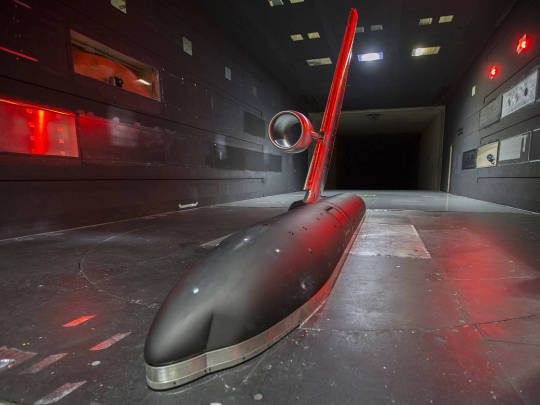
NASA’s Langley Research Center in Hampton, Virginia is currently testing new ways to fly aircraft more efficiently and safely, which includes a new high-lift aerodynamic wing design.
In order for a modern transport aircraft to safely operate at slow speeds for landing and takeoff operations, a high-lift system consisting of slotted flaps on the trailing edge of the wing is used to achieve the required lift performance. However, the slotted flaps and the associated subsystems are complex and protrude under the wing such that they increase air resistance, and consequently fuel burn, during cruise.
The NASA Advanced Air Transport Technology (AATT) Project is sponsoring the current research effort aimed at reducing the fuel burn of modern transport aircraft by replacing a conventional slotted flap with a simple-hinged flap featuring an integrated active flow control (AFC) system.
Find out more:
https://www.nasa.gov/image-feature/langley/high-lift-aerodynamic-wing-design-tested-at-nasa-langley-tunnel
Photo: NASA Langley Aerodynamic testing - NASA
0 notes
Link
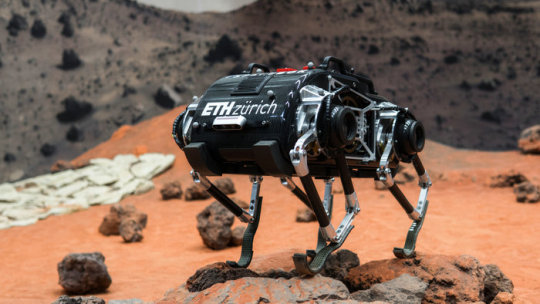
The walking and hopping robot ‘SpaceBok’ is currently being tested in ESA’s Mars Yard by Swiss engineers.
SpaceBok is a quadruped robot designed by a Swiss student team from ETH Zurich and ZHAW Zurich, under the supervision of Professor Marco Hutter and PhD student Hendrik Kolvenbach, for future missions to the Moon or Mars.
Legged robots have the advantage of traversing unstructured terrain and could be used to explore areas of interest, such as craters, which rovers are unable to reach. SpaceBok is primarily built for hopping, which is not particularly useful on Earth but could allow it to reach heights of up to four metres on the Moon. This would allow for a fast and efficient way of moving forward.
Find out more:
http://www.esa.int/spaceinimages/Images/2018/11/SpaceBok_robot
Photo: SpaceBok robot - ESA
#mehcanical#electrical#engineering#ingenious engineering#robotics#space travel#space exploration#moon#European Space Agency
0 notes
Link
youtube
Stanford researchers have developed an electronic glove that bestows robotic hands with some of the manual dexterity humans enjoy.
The electronic glove imitates the way layers of human skin work together to give our hands their extraordinary sensitivity. Stanford chemical engineer Zhenan Bao and her team demonstrated that the sensors work well enough to allow a robotic hand to touch a delicate berry and handle a pingpong ball without squashing them.
Bao said that with proper programming a robotic hand wearing the current touch-sensing glove could perform a repetitive task such as lifting eggs off a conveyor belt and placing them into cartons. The technology could also have applications in robot-assisted surgery, where precise touch control is essential. Her ultimate goal is to develop an advanced version of the glove that automatically applies just the right amount of force to handle an object safely without prior programming.
Find out more:
https://news.stanford.edu/2018/11/21/stanford-develops-electronic-glove-gives-robots-sense-touch/
Video: Robot hand moves a ping pong ball - Stanford University YouTube
#robotics#prosthetics#bionics#cybernetics#programming#artificial intelligence#stanford#biomedical#automation#ingenious engineering#electric#mechanical
0 notes
Link
Modern technologies such as 3D printing can completely revolutionise how we think about engineering, such as this example which happened during the development of a new jet engine at General Electric.
A decade ago, during development of the LEAP engine, the engineering team quickly recognised its success rested in many respects on the labyrinthine passages inside the tip of the fuel nozzle, but discovered the tip’s interior geometry was too intricate and near impossible to make.
In 2015, GE built the fuel nozzle a 3D-printing facility of its own, in Auburn. With more than 40 3D printers at the ready and a deep pool of talent from Auburn University, the plant delivered a total of 8,000 fuel nozzles in 2017. And, as of now, the total tally stands at over 33,000 3D-printed fuel nozzle tips.
Find out more:
https://www.ge.com/reports/transformation-3d-walnut-sized-part-changed-way-ge-aviation-builds-jet-engines/
Photo: GE jet engine - GE
#cfm international#general electric#mechanical#electrical#3D Printing#Jet engine#passenger jet#aeronautical#ingenious engineering#design#research
0 notes
Link
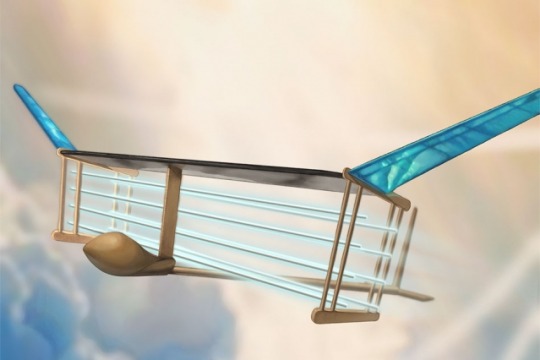
MIT engineers have successfully built and flown the first-ever plane with no moving parts.
Unlike turbine-powered planes, the aircraft does not depend on fossil fuels to fly. And unlike propeller-driven drones, the new design is completely silent. Instead of propellers or turbines, the light aircraft is powered by an “ionic wind” — a silent but mighty flow of ions that is produced aboard the plane, and that generates enough thrust to propel the plane over a sustained, steady flight.
MIT engineers expect that in the near-term, such ion wind propulsion systems could be used to fly less noisy drones. Further out, he envisions ion propulsion paired with more conventional combustion systems to create more fuel-efficient, hybrid passenger planes and other large aircraft.
Find out more:
http://news.mit.edu/2018/first-ionic-wind-plane-no-moving-parts-1121
Photo: A new MIT plane is propelled via ionic wind - MIT
#plane#flying#ingenious engineering#engineering#mechanical#mit#ionic#flight#propulsion#renewable#natural#fossil fuels
0 notes
Link
Inspired by the extraordinary characteristics of polar bear fur, lotus leaves and gecko feet, engineering researchers have developed a new way to make arrays of nanofibers that could bring us coatings that are sticky, repellent, insulating or light emitting, among other possibilities.
Researchers at U-M and the University of Wisconsin made the somewhat serendipitous discovery, which revealed a new and powerful method for making arrays of fibers that are hundreds of times thinner than a human hair.
The researchers have shown that their nanofibers repelled water like lotus leaves. They grew straight and curved fibers and tested how they stuck together like Velcro—finding that clockwise and counterclockwise twisted fibers knitted together more tightly than two arrays of straight fibers.
Find out more:
https://news.umich.edu/nanofiber-carpet-could-lead-to-new-sticky-or-insulating-surfaces/
Photo: Nanofiber carpet - Kenneth Cheng, Lahann Lab, Michigan Engineering
#nanotechnology#microfiber#Nanofibers#research#university#wisconsin#velcro#biomimetic#biomimicry#nature#ingenious engineering#biomedical
0 notes
Link
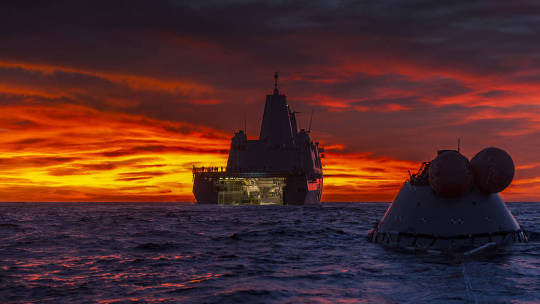
On Nov. 1, 2018, the USS John P. Murtha recovered the test version of the Orion capsule at sunset in the Pacific Ocean.
The Underway Recovery Test-7 (URT-7) is one in a series of tests that the Exploration Ground Systems Recovery Team, along with the U.S. Navy, are conducting to validate procedures and hardware that will be used to recover the Orion spacecraft after it splashes down following deep space exploration missions.
Orion will have the capability to sustain the crew during space travel, provide safe re-entry from deep space return velocities, and emergency abort.
Find out more:
https://www.nasa.gov/image-feature/recovery-of-the-test-orion-capsule-in-the-pacific-ocean
Photo: Orion capsule at sunset - NASA/Tony Gray
#nasa#orion#pacific ocean#recue#navy#spacecraft#mission#space exploration#space travel#ingenious engineering#engineering#mechanical#electronic#aeronautical
0 notes
Link
MIT researchers have devised an autonomous system for fleets of drones to collaboratively search under dense forest canopies. The drones use only onboard computation and wireless communication — no GPS required.
Each autonomous quadrotor drone is equipped with laser-range finders for position estimation, localization, and path planning. As the drone flies around, it creates an individual 3-D map of the terrain. Algorithms help it recognize unexplored and already-searched spots, so it knows when it’s fully mapped an area. An off-board ground station fuses individual maps from multiple drones into a global 3-D map that can be monitored by human rescuers.
The researchers tested multiple drones in simulations of randomly generated forests, and tested two drones in a forested area within NASA’s Langley Research Center. In both experiments, each drone mapped a roughly 20-square-meter area in about two to five minutes and collaboratively fused their maps together in real-time. The drones also performed well across several metrics, including overall speed and time to complete the mission, detection of forest features, and accurate merging of maps.
Find out more:
http://news.mit.edu/2018/fleets-drones-help-searches-lost-hikers-1102
Photo: MIT autonomous drone - MIT Melanie Gonick
#mit#massachusetts#drone#uav#autonomous#quadrocopter#research#university#nasa#electric#electronic#ingenious engineering
0 notes
Link
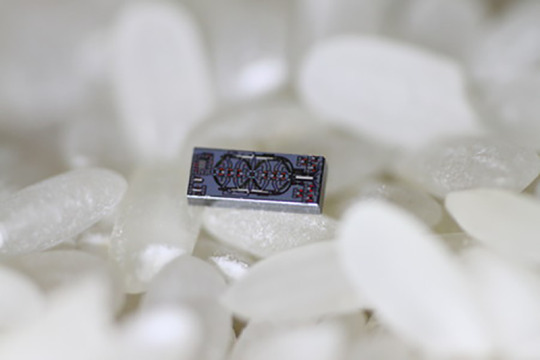
Caltech engineers led by Ali Hajimiri, Bren Professor of Electrical Engineering and Medical Engineering in the Division of Engineering and Applied Science, have developed a new optical gyroscope that is 500 times smaller than the current state-of-the-art device.
The new gyroscope from Hajimiri's lab achieves this improved performance by using a new technique called "reciprocal sensitivity enhancement." In this case, "reciprocal" means that it affects both beams of the light inside the gyroscope in the same way.
The Caltech team found a way to weed out this reciprocal noise while leaving signals from the Sagnac effect intact. Reciprocal sensitivity enhancement thus improves the signal-to-noise ratio in the system and enables the integration of the optical gyro onto a chip smaller than a grain of rice.
Find out more:
http://www.caltech.edu/news/spinning-light-worlds-smallest-optical-gyroscope-84183
Photo: The new optical gyroscope—shown here with grains of rice—is 500 times smaller than the current state-of-the-art device. - Ali Hajimiri
#engineering#electrical#electronic#microprocessor#microchip#ingenious engineering#university#research#optics#light
0 notes
Link
youtube
FlyCroTugs are micro air vehicles that the researchers have modified so the vehicles can anchor themselves to various surfaces using adhesives inspired by the feet of geckos and insects, previously developed in Cutkosky’s lab.
Developed in the labs of Mark Cutkosky, the Fletcher Jones Chair in the School of Engineering at Stanford University, and Dario Floreano at the École Polytechnique Fédérale de Lausanne in Switzerland, the FlyCroTugs can pull objects up to 40 times their weight, like door handles in one scenario, or cameras and water bottles in a rescue situation. Similar vehicles can only lift objects about twice their own weight using aerodynamic forces.
Each FlyCroTug has a winch with a cable and either microspines or gecko adhesive in order to tug. Beyond those fixed features they are otherwise highly modifiable. The location of the grippers can vary depending on the surface where they will be landing, and the researchers can also add parts for ground-based movement, such as wheels. Getting all of these features onto a small air vehicle with twice the weight of a golf ball was no small feat, according to the researchers.
Find out more:
https://news.stanford.edu/2018/10/24/small-flying-robots-haul-heavy-loads/
Video: Stanford researchers modify small flying robots to haul heavy loads - Stanford
0 notes